Serum Derivatives–Reactive Oxygen Metabolite Levels as a Marker of Clinical Conditions in Patients with Bronchial Asthma, COPD, or Asthma–COPD Overlap: A Prospective Study
Abstract
1. Introduction
2. Materials and Methods
2.1. Patients and Study Design
2.2. Laboratory Data
2.3. Measurement of Serum IL-6, IL-8 and TNF-α
2.4. Measurement of Serum d–ROMs Levels
2.5. Pulmonary Function Tests and Fractional Exhaled Nitric Oxide (FeNO) Level
2.6. Respiratory Questionnaire Scores
2.7. Statistical Analysis
3. Results
3.1. Patient Characteristics
3.2. Serum d–ROMs Levels
3.3. Relationship between Serum d–ROMs Levels and Biomarkers
3.4. Relationship between Serum d–ROMs Levels and Pulmonary Function Test
3.5. Relationship between Serum d–ROMs Levels and Respiratory Questionnaire Scores
4. Discussion
5. Conclusions
Author Contributions
Funding
Institutional Review Board Statement
Informed Consent Statement
Data Availability Statement
Conflicts of Interest
Abbreviations
| ACO | asthma–COPD overlap |
| ACT | asthma control test |
| ATS | American Thoracic Society |
| BA | bronchial asthma |
| CAT | COPD assessment test |
| COPD | chronic obstructive pulmonary disease |
| CRP | C-reactive protein |
| DLCO | diffusing capacity of the lung for carbon monoxide |
| d–ROMs | derivatives–reactive oxygen metabolites |
| ERS | European Respiratory Society |
| FeNO | fractional exhaled nitric oxide |
| FEV1 | forced expiratory volume in 1 s |
| FVC | forced vital capacity |
| GINA | Global Initiative for Asthma |
| GOLD | Global Initiative for Chronic Obstructive Lung Disease |
| HRCT | high-resolution computed tomography |
| ICS | inhaled corticosteroids |
| IgE | immunoglobulin E |
| IL | interleukin |
| JRS | Japanese Respiratory Society |
| LAA | low attenuation area |
| LAMA | long-acting muscarinic antagonists |
| LABA | long-acting beta2-agonists |
| OCS | oral corticosteroids |
| ROC | receiver operating characteristic |
| ROS | reactive oxygen species |
| SAA | serum amyloid A |
| SGRQ | St. George’s Respiratory Questionnaire |
| TNF-α | tumor necrosis factor alpha |
| WBC | white blood cell |
References
- Global Initiative for Asthma (GINA). Global Strategy for Asthma Management and Prevention. 2024. Available online: https://ginasthma.org/wp-content/uploads/2024/05/GINA-2024-Strategy-Report-24_05_22_WMS.pdf (accessed on 7 June 2024).
- Global Initiative for Chronic Obstructive Lung Disease (GOLD). Global Strategy for the Diagnosis, Management, and Prevention of Chronic Obstructive Pulmonary Disease. 2024. Available online: https://goldcopd.org/wp-content/uploads/2024/02/GOLD-2024_v1.2-11Jan24_WMV.pdf (accessed on 7 June 2024).
- Pola-Bibian, B.; Dominguez-Ortega, J.; Vilà-Nadal, G.; Entrala, A.; González-Cavero, L.; Barranco, P.; Cancelliere, N.; Díaz-Almirón, M.; Quirce, S. Asthma exacerbations in a tertiary hospital: Clinical features, triggers, and risk factors for hospitalization. J. Investig. Allergol. Clin. Immunol. 2017, 27, 238–245. [Google Scholar] [CrossRef] [PubMed][Green Version]
- Harada, N.; Harada, S.; Ito, J.; Atsuta, R.; Hori, S.; Takahashi, K. Mobile health app for Japanese adult patients with asthma: Clinical observational study. J. Med. Internet Res. 2020, 22, e19006. [Google Scholar] [CrossRef] [PubMed]
- Postma, D.S.; Kerkhof, M.; Boezen, H.M.; Koppelman, G.H. Asthma and chronic obstructive pulmonary disease: Common genes, common environments? Am. J. Respir. Crit. Care Med. 2011, 183, 1588–1594. [Google Scholar] [CrossRef] [PubMed]
- Svanes, C.; Sunyer, J.; Plana, E.; Dharmage, S.; Heinrich, J.; Jarvis, D.; de Marco, R.; Norback, D.; Raherison, C.; Villani, S.; et al. Early life origins of chronic obstructive pulmonary disease. Thorax 2010, 65, 14–20. [Google Scholar] [CrossRef]
- Sapey, E.; Stockley, R.A. COPD exacerbations. 2: Aetiology. Thorax 2006, 61, 250–258. [Google Scholar]
- Chow, R.; So, O.W.; Im, J.H.B.; Chapman, K.R.; Orchanian-Cheff, A.; Gershon, A.S.; Wu, R. Predictors of readmission, for patients with chronic obstructive pulmonary disease (COPD)—A systematic review. Int. J. Chronic Obstr. Pulm. Dis. 2023, 18, 2581–2617. [Google Scholar] [CrossRef] [PubMed]
- Hashimoto, S.; Yoshida, Y.; Makita, N.; Sorimachi, R.; Sugaya, S.; Arita, Y.; Hayashi, N.; Tashiro, N.; Ichinose, M. Real-world evidence on the diagnostic and clinical characteristics of asthma in Japanese patients with COPD: The ACO Japan Cohort Study. Int. J. Chronic Obstr. Pulm. Dis. 2023, 18, 37–46. [Google Scholar] [CrossRef]
- Zinellu, E.; Zinellu, A.; Fois, A.G.; Pau, M.C.; Scano, V.; Piras, B.; Carru, C.; Pirina, P. Oxidative stress biomarkers in chronic obstructive pulmonary disease exacerbations: A systematic review. Antioxidants 2021, 10, 710. [Google Scholar] [CrossRef]
- Pigazzani, F.; Gorni, D.; Dyar, K.A.; Pedrelli, M.; Kennedy, G.; Costantino, G.; Bruno, A.; Mackenzie, I.; MacDonald, T.M.; Tietge, U.J.F.; et al. The prognostic value of derivatives-reactive oxygen metabolites (d-ROMs) for cardiovascular disease events and mortality: A review. Antioxidants 2022, 11, 1541. [Google Scholar] [CrossRef]
- Poprac, P.; Jomova, K.; Simunkova, M.; Kollar, V.; Rhodes, C.J.; Valko, M. Targeting free radicals in oxidative stress-related human diseases. Trends Pharmacol. Sci. 2017, 38, 592–607. [Google Scholar] [CrossRef]
- Yamamura, K.; Nojiri, M.; Nishiki, K.; Kato, R.; Shinomiya, S.; Takahara, Y.; Oikawa, T.; Ishizaki, T.; Toga, H.; Mizuno, S. Serum derivatives of reactive oxygen metabolites are associated with severity of chronic obstructive pulmonary disease and affected by a p53 gene polymorphism. Int. J. Chronic Obstr. Pulm. Dis. 2022, 17, 1589–1600. [Google Scholar] [CrossRef]
- Wakabayashi, H.; Matsuzawa, Y.; Hayakawa, S.; Irie, T.; Rikitake, H.; Tatsuno, I. Serum oxidative stress in patients with pulmonary Mycobacterium avium complex disease. Heliyon 2019, 5, e02775. [Google Scholar] [CrossRef] [PubMed]
- Yamamura, K.; Hara, J.; Kobayashi, T.; Ohkura, N.; Abo, M.; Akasaki, K.; Nomura, S.; Yuasa, M.; Saeki, K.; Terada, N.; et al. The prevalence and clinical features of asthma–COPD overlap (ACO) definitively diagnosed according to the Japanese Respiratory Society Guidelines for the Management of ACO 2018. J. Med. Investig. 2019, 66, 157–164. [Google Scholar] [CrossRef] [PubMed]
- Cornelli, U.; Cornelli, M.; Terranova, R. Free-radical and vascular disease. J. Int. Union Angiol. Bull. 1999, 15, 7–10. [Google Scholar]
- Thomas, M.; Kay, S.; Pike, J.; Williams, A.; Rosenzweig, J.R.; Hillyer, E.V.; Price, D. The Asthma Control Test (ACT) as a predictor of GINA guideline-defined asthma control: Analysis of a multinational cross-sectional survey. Prim. Care Respir. J. 2009, 18, 41–49. [Google Scholar] [CrossRef] [PubMed]
- Jones, P.W.; Harding, G.; Berry, P.; Wiklund, I.; Chen, W.H.; Kline Leidy, N. Development and first validation of the COPD assessment test. Eur. Respir. J. 2009, 34, 648–654. [Google Scholar] [CrossRef]
- Jones, P.W.; Quirk, F.H.; Baveystock, C.M.; Littlejohns, P. A self-complete measure of health status for chronic airflow limitation. The St. George’s Respiratory Questionnaire. Am. Rev. Respir. Dis. 1992, 145, 1321–1327. [Google Scholar] [CrossRef]
- Mishra, V.; Banga, J.; Silveyra, P. Oxidative stress and cellular pathways of asthma and inflammation: Therapeutic strategies and pharmacological targets. Pharmacol. Ther. 2018, 181, 169–182. [Google Scholar] [CrossRef]
- Albano, G.D.; Gagliardo, R.P.; Montalbano, A.M.; Profita, M. Overview of the mechanisms of oxidative stress: Impact in inflammation of the airway diseases. Antioxidants 2022, 11, 2237. [Google Scholar] [CrossRef]
- Sahiner, U.M.; Birben, E.; Erzurum, S.; Sackesen, C.; Kalayci, Ö. Oxidative stress in asthma: Part of the puzzle. Pediatr. Allergy Immunol. 2018, 29, 789–800. [Google Scholar] [CrossRef]
- Kotsiou, O.S.; Tourlakopoulos, K.; Kontopoulou, L.; Mavrovounis, G.; Pantazopoulos, I.; Kirgou, P.; Zarogiannis, S.G.; Daniil, Z.; Gourgoulianis, K.I. D-ROMs and PAT Tests Reveal a High Level of Oxidative Stress in Patients with Severe Well-Controlled Asthma, and D-ROMs Are Positively Correlated with R20 Values That Indicate Approximate Central Airway Resistance. J. Pers. Med. 2023, 13, 943. [Google Scholar] [CrossRef] [PubMed]
- Nakamoto, K.; Watanabe, M.; Sada, M.; Inui, T.; Nakamura, M.; Honda, K.; Wada, H.; Mikami, Y.; Matsuzaki, H.; Horie, M.; et al. Serum reactive oxygen metabolite levels predict severe exacerbations of asthma. PLoS ONE 2016, 11, e0164948. [Google Scholar] [CrossRef]
- Nathan, R.A.; Sorkness, C.A.; Kosinski, M.; Schatz, M.; Li, J.T.; Marcus, P.; Murray, J.J.; Pendergraft, T.B. Development of the asthma control test: A survey for assessing asthma control. J. Allergy Clin. Immunol. 2004, 113, 59–65. [Google Scholar] [CrossRef] [PubMed]
- Ding, B.; Chen, S.; Srivastava, D.; Quinton, A.; Cook, W.; Papi, A.; Reddel, H.K. Symptom burden, health status, and productivity in patients with uncontrolled and controlled severe asthma in NOVELTY. J. Asthma Allergy 2023, 16, 611–624. [Google Scholar] [CrossRef]
- Juniper, E.F.; Bousquet, J.; Abetz, L.; Bateman, E.D. Identifying ‘well-controlled’ and ‘not well-controlled’ asthma using the Asthma Control Questionnaire. Respir. Med. 2006, 100, 616–621. [Google Scholar] [CrossRef] [PubMed]
- Agustí, A.; Hogg, J.C. Update on the pathogenesis of chronic obstructive pulmonary disease. N. Engl. J. Med. 2019, 381, 1248–1256. [Google Scholar] [CrossRef]
- Sharafkhaneh, A.; Hanania, N.A.; Kim, V. Pathogenesis of emphysema: From the bench to the bedside. Proc. Am. Thorac. Soc. 2008, 5, 475–477. [Google Scholar] [CrossRef]
- Barnes, P.J. Oxidative Stress in Chronic Obstructive Pulmonary Disease. Antioxidants 2022, 11, 965. [Google Scholar] [CrossRef]
- Zinellu, E.; Zinellu, A.; Fois, A.G.; Carru, C.; Pirina, P. Circulating biomarkers of oxidative stress in chronic obstructive pulmonary disease: A systematic review. Respir. Res. 2016, 17, 150. [Google Scholar] [CrossRef]
- Melillo, G.; Iorio, E.; Giuliano, F.; Balzano, G.; Melillo, E. Oxidative stress in patients with chronic obstructive pulmonary disease: Validation of a new photometric test (exhalation test) for the measurement of hydrogen peroxide in exhaled breath condensate. Ressegna Patol. dell’Apparato Respir. 2007, 22, 98–104. [Google Scholar]
- Barnes, P.J.; Chowdhury, B.; Kharitonov, S.A.; Magnussen, H.; Page, C.P.; Postma, D.; Saetta, M. Pulmonary biomarkers in chronic obstructive pulmonary disease. Am. J. Respir. Crit. Care Med. 2006, 174, 6–14. [Google Scholar] [CrossRef] [PubMed]
- Kurashima, K.; Takaku, Y.; Ohta, C.; Takayanagi, N.; Yanagisawa, T.; Sugita, Y. COPD assessment test and severity of airflow limitation in patients with asthma, COPD, and asthma–COPD overlap syndrome. Int. J. Chronic Obstr. Pulm. Dis. 2016, 11, 479–487. [Google Scholar] [CrossRef] [PubMed]
- Miravitlles, M.; Soriano, J.B.; Ancochea, J.; Muñoz, L.; Duran-Tauleria, E.; Sánchez, G.; Sobradillo, V.; García-Río, F. Characterisation of the overlap COPD–asthma phenotype. Focus on physical activity and health status. Respir. Med. 2013, 107, 1053–1060. [Google Scholar] [CrossRef] [PubMed]
- Menezes, A.M.B.; Montes de Oca, M.; Pérez-Padilla, R.; Nadeau, G.; Wehrmeister, F.C.; Lopez-Varela, M.V.; Muiño, A.; Jardim, J.R.B.; Valdivia, G.; Tálamo, C. Increased risk of exacerbation and hospitalization in subjects with an overlap phenotype: COPD–asthma. Chest 2014, 145, 297–304. [Google Scholar] [CrossRef]
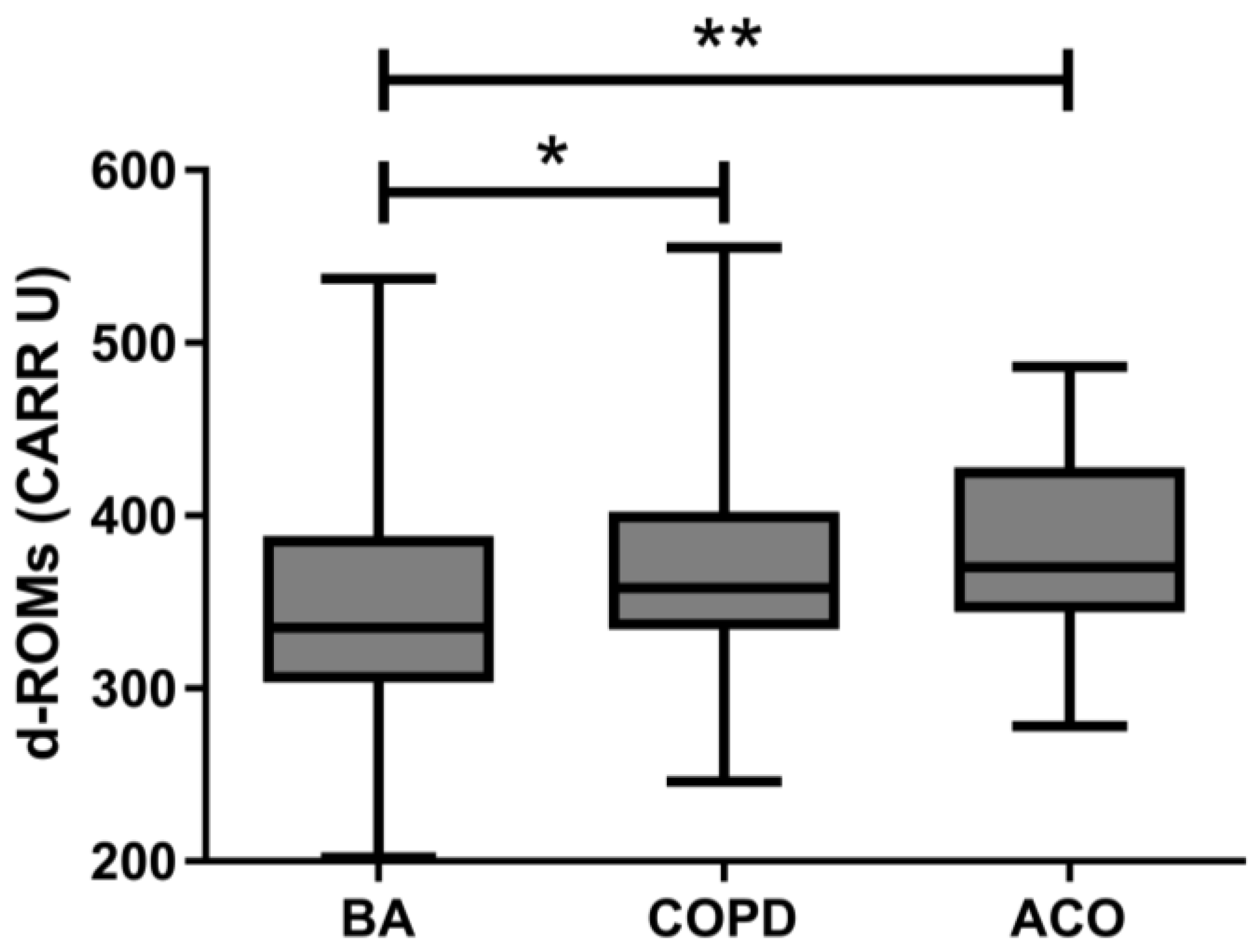
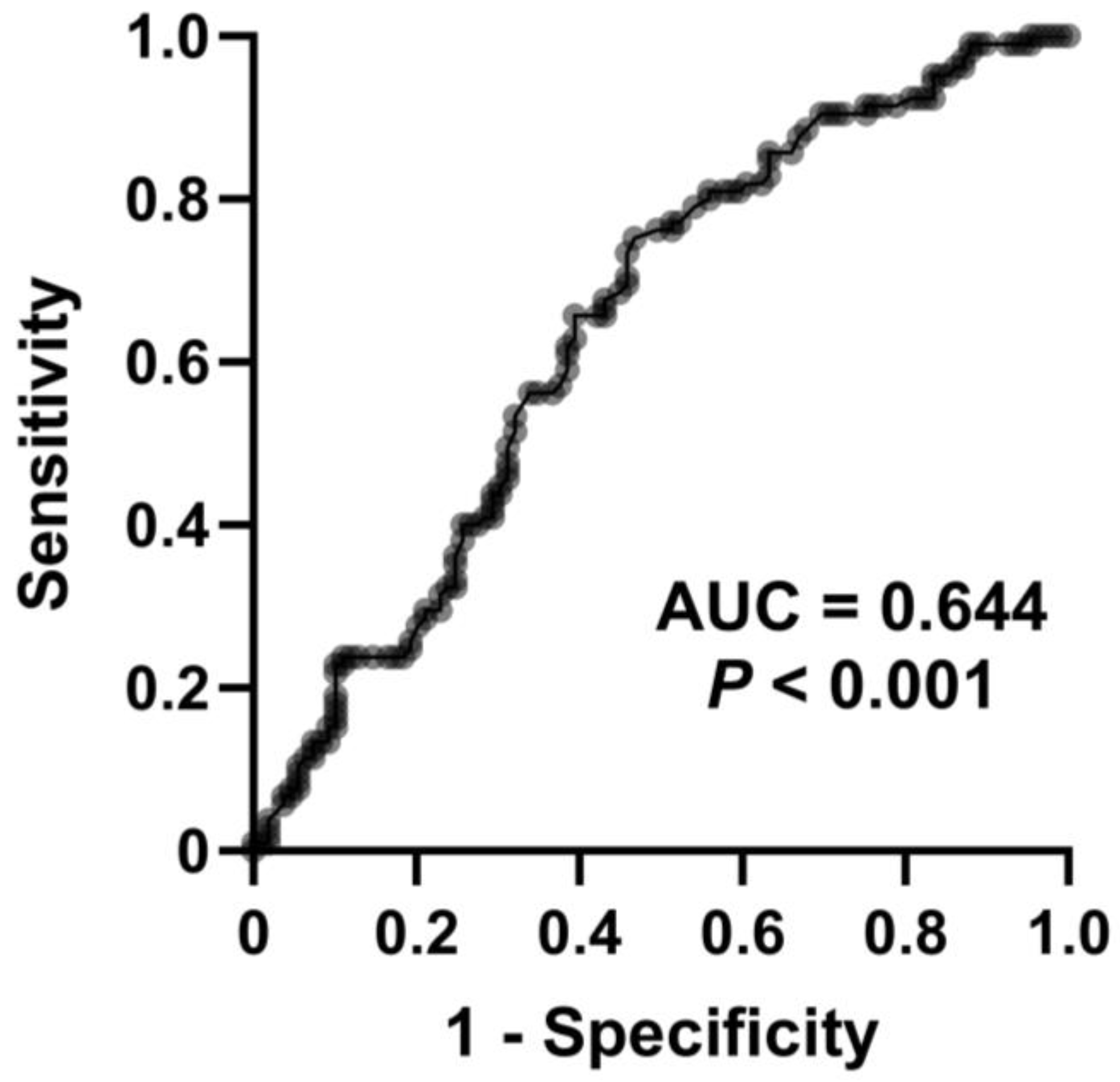
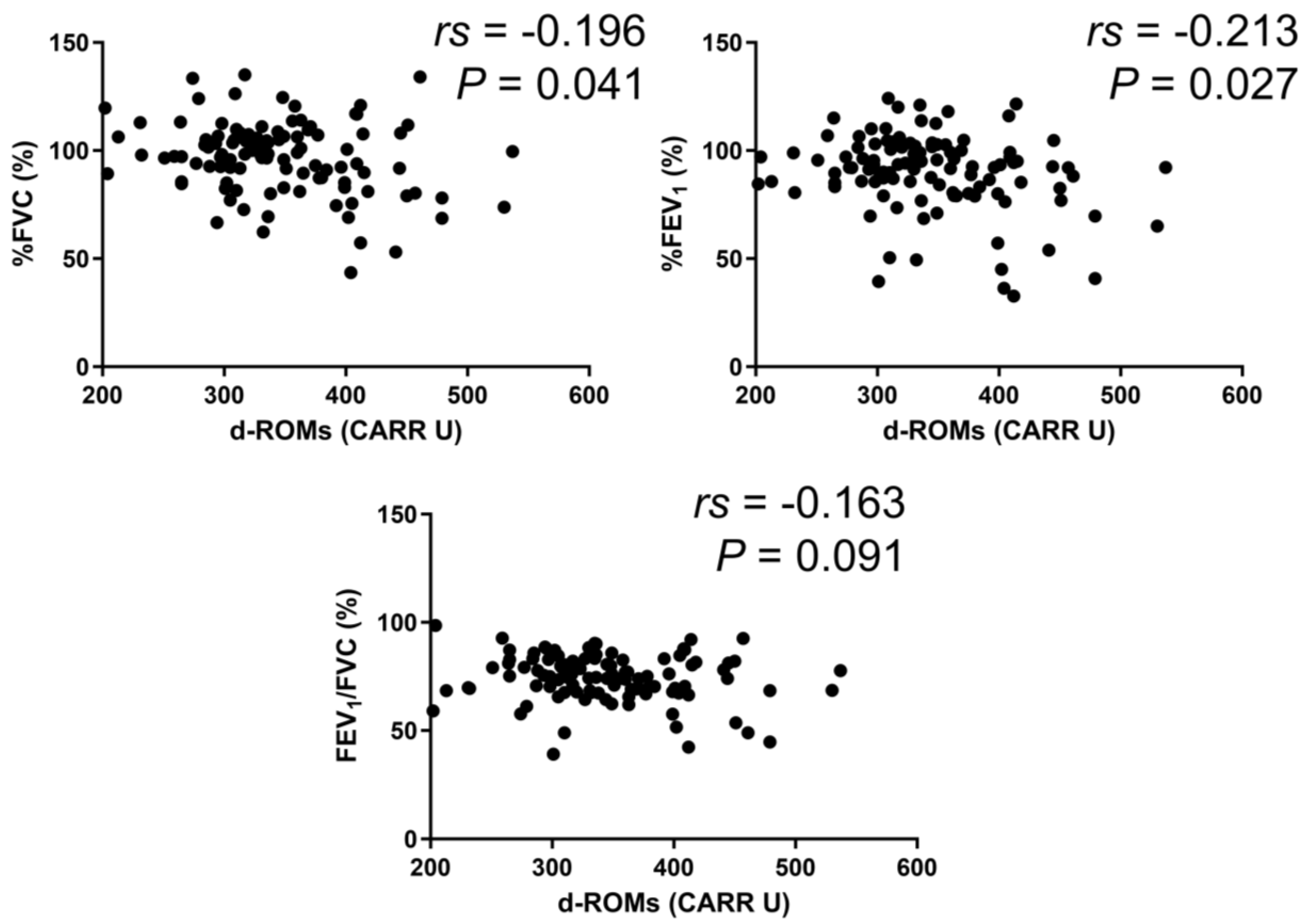
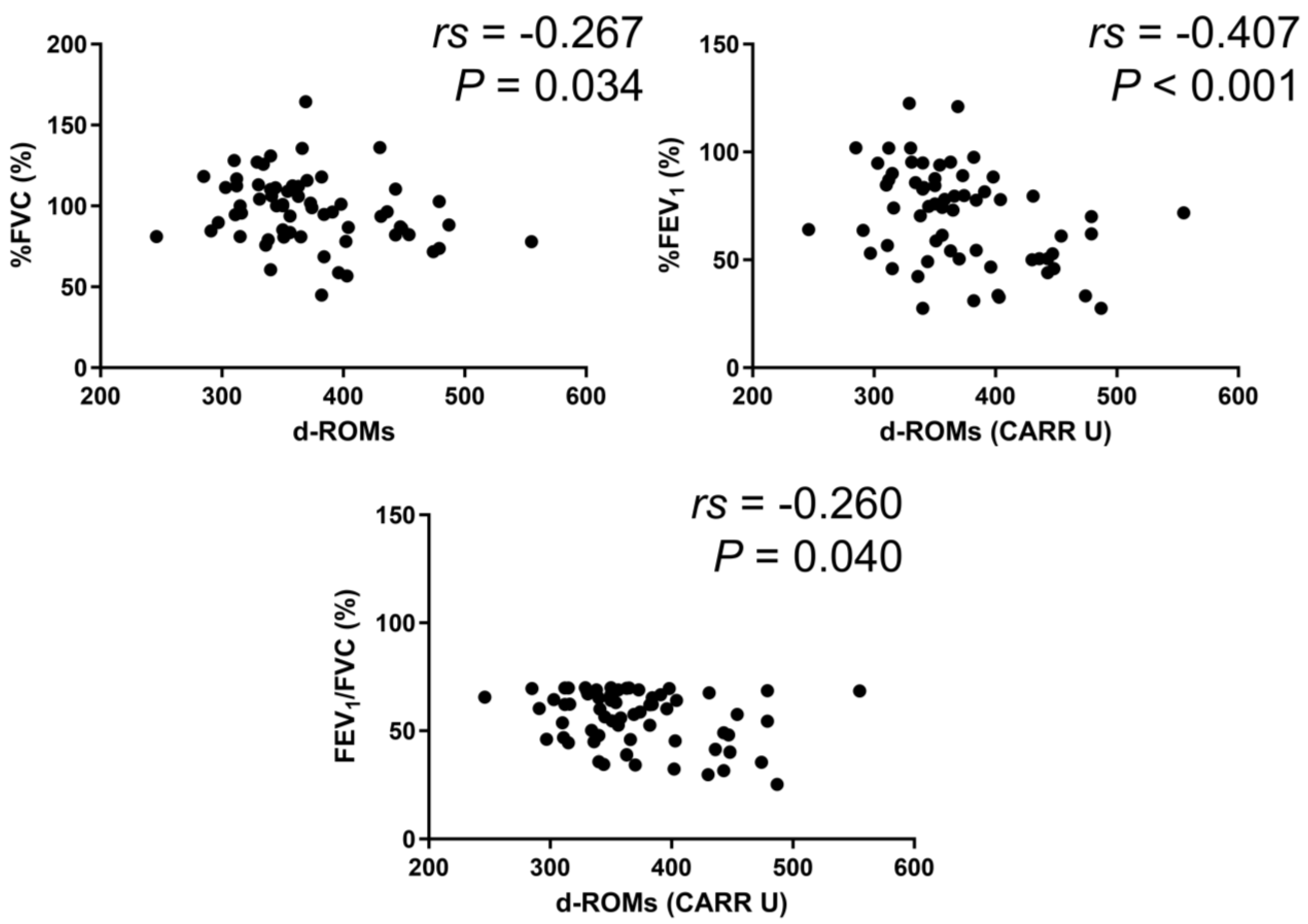

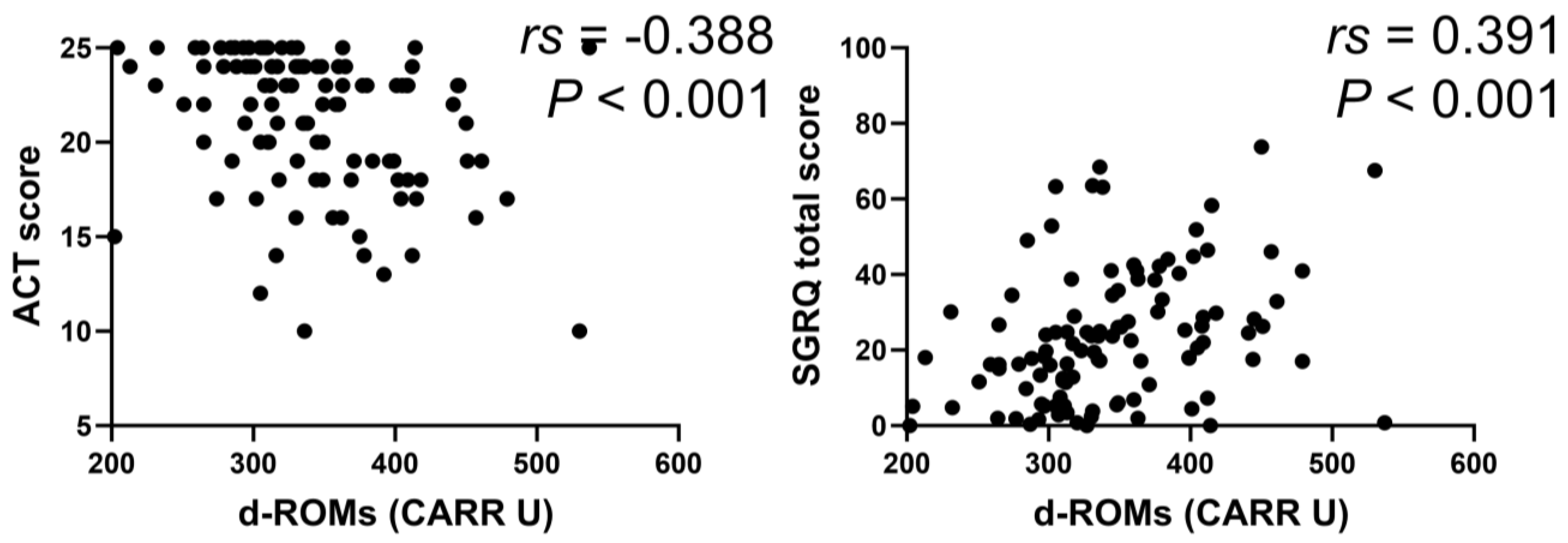


| Basic Characteristics | |
|---|---|
| |
| |
| Features of BA | Features of COPD |
| 2 items from 1–3 apply or 1 item from 1–3 and 2 items from 4 apply. | 1 item from 1–3 apply. |
| 1. Variable (diurnally, daily, seasonally) or paroxysmal respiratory symptoms (cough, sputum, dyspnea) | 1. Smoking history (≥10 pack-years) or same level of air pollution exposure |
| 2. BA diagnosis history under 40 years | 2. Presence of low attenuation area showing emphysematous changes on chest CT |
| 3. FeNO > 35 ppb | 3. Impaired pulmonary diffusing capacity (DLCO < 0.8 or DLCO/VA < 0.8) |
| 4-1. Complication of allergic rhinitis | |
| 4-2. Bronchodilator response of FEV1 ≥ 200 mL and 12% from baseline | |
| 4-3. Peripheral blood eosinophil count > 5% or 300 cells/μL | |
| 4-4. High levels of IgE (total IgE or specific IgE against perennial inhalant antigens) | |
| BA | COPD | ACO | p | p | p | |
|---|---|---|---|---|---|---|
| N = 109 | N = 63 | N = 42 | BA vs. COPD | BA vs. ACO | COPD vs. ACO | |
| Age, years | 64 (51–74) | 78 (73–83) | 73 (66–79) | <0.001 | 0.001 | 0.058 |
| Gender, male | 44 (40.4) | 53 (84.1) | 36 (85.7) | <0.001 | <0.001 | 0.825 |
| Never smoker | 71 (65.1) | 0 (0.0) | 0 (0.0) | <0.001 | <0.001 | 1.000 |
| Ex smoker | 33 (30.3) | 50 (79.4) | 35 (83.3) | <0.001 | <0.001 | 0.612 |
| Current smoker | 5 (4.6) | 13 (20.6) | 7 (16.7) | <0.001 | 0.014 | 0.612 |
| Smoking, pack-years | 0 (0–6) | 55 (40–68) | 40 (29–54) | <0.001 | <0.001 | 0.280 |
| Comorbidities | ||||||
| Rhinitis | 47 (43.1) | 4 (6.3) | 13 (31.0) | <0.001 | 0.171 | 0.001 |
| Atopic dermatitis | 9 (8.3) | 0 (0.0) | 5 (11.9) | 0.019 | 0.489 | 0.005 |
| Sinusitis | 22 (20.2) | 3 (4.8) | 9 (21.4) | 0.006 | 0.865 | 0.009 |
| Hypertension | 42 (38.5) | 27 (42.9) | 20 (47.6) | 0.577 | 0.309 | 0.631 |
| Hyperlipidemia | 21 (19.3) | 10 (15.9) | 14 (33.3) | 0.577 | 0.066 | 0.037 |
| Diabetes mellitus | 18 (16.5) | 7 (11.1) | 3 (7.1) | 0.225 | 0.092 | 0.497 |
| Laboratory data | ||||||
| WBC, /µL | 6200 (5050–7450) | 6000 (5100–7000) | 6850 (5900–7530) | >0.999 | 0.150 | 0.098 |
| Blood neutrophil count, /µL | 3550 (2840–4830) | 3760 (3130–4650) | 3820 (3260–4940) | >0.999 | 0.494 | >0.999 |
| Blood eosinophil count, /µL | 180 (90–340) | 140 (100–200) | 360 (190–530) | 0.161 | 0.006 | <0.001 |
| Blood eosinophil count, % | 2.8 (1.4–5.6) | 2.4 (1.6–3.4) | 4.3 (2.6–8.3) | 0.103 | 0.053 | <0.001 |
| d–ROMs, CARR U | 335 (304–388) | 358 (334–402) | 370 (344–428) | 0.018 | 0.004 | >0.999 |
| CRP, mg/dL | 0.08 (0.04–0.19) | 0.14 (0.05–0.35) | 0.14 (0.04–0.31) | 0.196 | 0.085 | >0.999 |
| SAA, µg/mL | 5.1 (3.0–10.8) | 6.1 (0.0–12.0) | 6.1 (3.2–11.6) | >0.999 | >0.999 | >0.999 |
| IL-6, pg/mL | 1.8 (1.2–3.5) | 3.1 (1.7–4.7) | 3.7 (2.1–6.9) | 0.003 | <0.001 | 0.199 |
| IL-8, pg/mL | 15.7 (11.3–21.4) | 21.0 (16.0–31.9) | 19.2 (14.3–24.9) | <0.001 | 0.063 | 0.736 |
| TNF-α, pg/mL | 0.7 (0.3–1.0) | 0.7 (0.5–1.0) | 0.9 (0.6–1.3) | 0.286 | 0.003 | 0.283 |
| IgE, IU/mL | 110 (40–340) | 40 (20–150) | 150 (50–640) | 0.002 | 0.608 | <0.001 |
| specific IgE against antigens, number | 3 (1–6) | 1 (0–2) | 3 (1–7) | <0.001 | >0.999 | 0.002 |
| Pulmonary function test | ||||||
| FVC, % predicted | 98.3 (86.5–107.3) | 96.4 (81.0–111.4) | 95.9 (86.3–104.9) | >0.999 | >0.999 | >0.999 |
| FEV1, % predicted | 92.2 (82.9–101.7) | 74.1 (50.5–87.0) | 71.1 (58.1–80.0) | <0.001 | <0.001 | 0.820 |
| FEV1/FVC, % | 75.2 (68.4–82.1) | 60.1 (46.1–67.1) | 56.3 (48.4–64.1) | <0.001 | <0.001 | >0.999 |
| FeNO, ppb | 26 (17–45) | 21 (13–28) | 38 (24–59) | 0.018 | 0.062 | <0.001 |
| Symptom | ||||||
| ACT Score | 22 (19–24) | NA | 20 (18–23) | NA | 0.052 | NA |
| CAT Score | NA | 10 (5–19) | 13 (9–17) | NA | NA | 0.224 |
| SGRQ Score | 20.2 (8.1–33.2) | 26.1 (14.0–39.8) | 28.8 (17.0–41.4) | 0.225 | 0.075 | >0.999 |
| Treatment | ||||||
| ICS use | 102 (93.6) | 16 (25.4) | 34 (81.0) | <0.001 | 0.020 | <0.001 |
| LABA use | 82 (75.2) | 49 (77.8) | 36 (85.7) | 0.379 | 0.162 | 0.310 |
| LAMA use | 23 (21.1) | 46 (73.0) | 27 (64.3) | <0.001 | <0.001 | 0.341 |
| OCS use | 14 (12.8) | 0 (0.0) | 4 (9.5) | 0.003 | 0.573 | 0.012 |
| Biologics use | 14 (12.8) | 0 (0.0) | 3 (7.1) | 0.003 | 0.321 | 0.031 |
| BA | COPD | ACO | ||||
|---|---|---|---|---|---|---|
| rs | p | rs | p | rs | p | |
| Age | 0.275 | 0.004 | 0.028 | 0.829 | 0.241 | 0.124 |
| pack-years | −0.171 | 0.076 | −0.057 | 0.659 | −0.076 | 0.633 |
| WBC | 0.253 | 0.008 | 0.265 | 0.036 | 0.023 | 0.884 |
| Neutrophils | 0.293 | 0.002 | 0.265 | 0.036 | 0.257 | 0.100 |
| Eosinophils | −0.123 | 0.204 | 0.431 | <0.001 | −0.003 | 0.835 |
| IgE | 0.061 | 0.526 | −0.020 | 0.879 | 0.145 | 0.360 |
| CRP | 0.375 | <0.001 | 0.431 | <0.001 | 0.440 | 0.004 |
| SAA | 0.316 | 0.001 | 0.408 | 0.001 | 0.487 | 0.001 |
| IL-6 | 0.270 | 0.004 | 0.487 | <0.001 | 0.483 | 0.001 |
| IL-8 | 0.232 | 0.015 | 0.118 | 0.358 | 0147 | 0.352 |
| TNF-α | −0.038 | 0.691 | 0.035 | 0.787 | 0.417 | 0.006 |
| FeNO | 0.011 | 0.912 | −0.160 | 0.212 | −0.039 | 0.808 |
| ACT Score | −0.388 | <0.001 | NA | NA | −0.280 | 0.072 |
| CAT Score | NA | NA | 0.442 | <0.001 | 0.329 | 0.034 |
| SGRQ Score | 0.391 | <0.001 | 0.406 | 0.001 | 0.440 | 0.004 |
Disclaimer/Publisher’s Note: The statements, opinions and data contained in all publications are solely those of the individual author(s) and contributor(s) and not of MDPI and/or the editor(s). MDPI and/or the editor(s) disclaim responsibility for any injury to people or property resulting from any ideas, methods, instructions or products referred to in the content. |
© 2024 by the authors. Licensee MDPI, Basel, Switzerland. This article is an open access article distributed under the terms and conditions of the Creative Commons Attribution (CC BY) license (https://creativecommons.org/licenses/by/4.0/).
Share and Cite
Nakamoto, K.; Watanabe, M.; Saito, M.; Kasuga, K.; Miyaoka, C.; Yoshida, Y.; Kobayashi, F.; Nunokawa, H.; Aso, J.; Nakamoto, Y.; et al. Serum Derivatives–Reactive Oxygen Metabolite Levels as a Marker of Clinical Conditions in Patients with Bronchial Asthma, COPD, or Asthma–COPD Overlap: A Prospective Study. J. Clin. Med. 2024, 13, 6022. https://doi.org/10.3390/jcm13196022
Nakamoto K, Watanabe M, Saito M, Kasuga K, Miyaoka C, Yoshida Y, Kobayashi F, Nunokawa H, Aso J, Nakamoto Y, et al. Serum Derivatives–Reactive Oxygen Metabolite Levels as a Marker of Clinical Conditions in Patients with Bronchial Asthma, COPD, or Asthma–COPD Overlap: A Prospective Study. Journal of Clinical Medicine. 2024; 13(19):6022. https://doi.org/10.3390/jcm13196022
Chicago/Turabian StyleNakamoto, Keitaro, Masato Watanabe, Masaoki Saito, Keisuke Kasuga, Chika Miyaoka, Yuki Yoshida, Fumi Kobayashi, Hiroki Nunokawa, Jumpei Aso, Yasuo Nakamoto, and et al. 2024. "Serum Derivatives–Reactive Oxygen Metabolite Levels as a Marker of Clinical Conditions in Patients with Bronchial Asthma, COPD, or Asthma–COPD Overlap: A Prospective Study" Journal of Clinical Medicine 13, no. 19: 6022. https://doi.org/10.3390/jcm13196022
APA StyleNakamoto, K., Watanabe, M., Saito, M., Kasuga, K., Miyaoka, C., Yoshida, Y., Kobayashi, F., Nunokawa, H., Aso, J., Nakamoto, Y., Ishida, M., Sada, M., Honda, K., Takata, S., Saraya, T., Shimoda, M., Tanaka, Y., Saotome, M., Ohta, K., & Ishii, H. (2024). Serum Derivatives–Reactive Oxygen Metabolite Levels as a Marker of Clinical Conditions in Patients with Bronchial Asthma, COPD, or Asthma–COPD Overlap: A Prospective Study. Journal of Clinical Medicine, 13(19), 6022. https://doi.org/10.3390/jcm13196022







